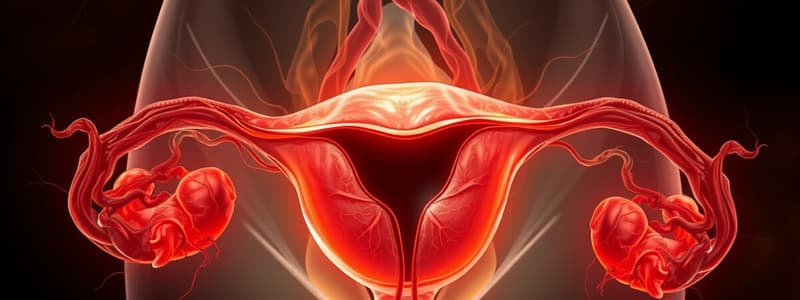Podcast
Questions and Answers
What is the traditional definition of postpartum hemorrhage (PPH) for vaginal spontaneous delivery?
What is the traditional definition of postpartum hemorrhage (PPH) for vaginal spontaneous delivery?
- Blood loss of ≧ 500 mL (correct)
- Blood loss of ≧ 400 mL
- Blood loss of ≧ 300 mL
- Blood loss of ≧ 600 mL
What constitutes the updated definition of PPH according to ACOG in 2017?
What constitutes the updated definition of PPH according to ACOG in 2017?
- Blood loss ≧ 800 mL with no symptoms
- Blood loss ≧ 500 mL accompanied by symptoms of hypovolemic shock
- Blood loss ≧ 1000 mL without signs of hypovolemia
- Blood loss ≧ 1000 mL accompanied by signs of hypovolemia (correct)
What type of PPH occurs within the first 24 hours post delivery?
What type of PPH occurs within the first 24 hours post delivery?
- Late PPH
- Acute PPH
- Early PPH (correct)
- Chronic PPH
Which factor is mentioned as a potential cause of uterine relaxation during pregnancy?
Which factor is mentioned as a potential cause of uterine relaxation during pregnancy?
What is a key reason for diagnosing conditions such as chorioamnionitis during prenatal checkups?
What is a key reason for diagnosing conditions such as chorioamnionitis during prenatal checkups?
What amount of blood loss is considered PPH for a cesarean section?
What amount of blood loss is considered PPH for a cesarean section?
What is a common medical condition treated with magnesium sulfate during pregnancy?
What is a common medical condition treated with magnesium sulfate during pregnancy?
Which of the following statements about the timing of hemorrhage is true?
Which of the following statements about the timing of hemorrhage is true?
What should be considered if there is no evidence of placental detachment?
What should be considered if there is no evidence of placental detachment?
Which of the following is not a complication associated with procedures mentioned?
Which of the following is not a complication associated with procedures mentioned?
Which conservative procedure is used to conserve fertility before hysterectomy?
Which conservative procedure is used to conserve fertility before hysterectomy?
What is a potential outcome of performing the ligation procedures mentioned?
What is a potential outcome of performing the ligation procedures mentioned?
What anatomical feature should be checked for during the inspection of the placenta?
What anatomical feature should be checked for during the inspection of the placenta?
What should be inspected for completeness after delivery to prevent complications?
What should be inspected for completeness after delivery to prevent complications?
Which of the following complications can occur due to surgical interventions during childbirth?
Which of the following complications can occur due to surgical interventions during childbirth?
What condition might be indicated by blood vessels traversing the placental membrane?
What condition might be indicated by blood vessels traversing the placental membrane?
What non-surgical technique involves using both hands to compress the uterus?
What non-surgical technique involves using both hands to compress the uterus?
Which procedure is unlikely to be helpful for a patient with placenta succenturiata?
Which procedure is unlikely to be helpful for a patient with placenta succenturiata?
Which of the following risk factors is not mentioned in relation to uterine complications?
Which of the following risk factors is not mentioned in relation to uterine complications?
What is the purpose of administering uterotonic agents after delivery?
What is the purpose of administering uterotonic agents after delivery?
Which of the following is performed if uterine bleeding is unresponsive to uterotonic agents?
Which of the following is performed if uterine bleeding is unresponsive to uterotonic agents?
What is the purpose of balloon tamponade in the management of postpartum hemorrhage?
What is the purpose of balloon tamponade in the management of postpartum hemorrhage?
What is a possible outcome of total hysterectomy performed due to uncontrolled bleeding?
What is a possible outcome of total hysterectomy performed due to uncontrolled bleeding?
Which method relies on filling a balloon with saline to tamponade bleeding?
Which method relies on filling a balloon with saline to tamponade bleeding?
What is the primary cause of a vulvar hematoma?
What is the primary cause of a vulvar hematoma?
Which of the following complications is associated with Angiographic Embolization?
Which of the following complications is associated with Angiographic Embolization?
What risk factor is commonly associated with abruptio placenta?
What risk factor is commonly associated with abruptio placenta?
What is a retained succenturiate lobe's significance in placental complications?
What is a retained succenturiate lobe's significance in placental complications?
Which option correctly describes the nature of bleeding in abruptio placenta?
Which option correctly describes the nature of bleeding in abruptio placenta?
Which statement about Angiographic Embolization is incorrect?
Which statement about Angiographic Embolization is incorrect?
What should be highly considered when assessing complications during delivery?
What should be highly considered when assessing complications during delivery?
Which of the below conditions is NOT a complication of Angiographic Embolization?
Which of the below conditions is NOT a complication of Angiographic Embolization?
What is one of the risk factors for developing bleeding due to retained placenta?
What is one of the risk factors for developing bleeding due to retained placenta?
What occurs during uterine inversion?
What occurs during uterine inversion?
Which of the following is NOT a risk factor for bleeding due to overstretched uterus?
Which of the following is NOT a risk factor for bleeding due to overstretched uterus?
What is a primary cause of bleeding in the event of genital tract trauma?
What is a primary cause of bleeding in the event of genital tract trauma?
What clinical action is recommended when there are signs of placental separation but vaginal bleeding persists?
What clinical action is recommended when there are signs of placental separation but vaginal bleeding persists?
Which of the following statements regarding uterine rupture is correct?
Which of the following statements regarding uterine rupture is correct?
Which condition represents a severe risk if pelvic floor muscles are weakened?
Which condition represents a severe risk if pelvic floor muscles are weakened?
What does persistent vaginal bleeding despite a contracted uterus indicate?
What does persistent vaginal bleeding despite a contracted uterus indicate?
Flashcards are hidden until you start studying
Study Notes
Definitions and Classifications of Postpartum Hemorrhage (PPH)
- PPH traditionally defined: Vaginal Spontaneous Delivery (VSD) blood loss ≥ 500 mL; Cesarean Section (CS) blood loss ≥ 1000 mL.
- American College of Obstetricians and Gynecologists (ACOG, 2017) revised definition: PPH as blood loss ≥ 1000 mL with hypovolemia symptoms.
- PPH classification includes early (within 24 hours post-delivery) and late (after 24 hours post-delivery).
Causes of Insufficient Uterine Contractions
- Distortion, uterine myomas, and placenta previa affect uterine contractions.
- Diagnosis of conditions such as chorioamnionitis and uterine abnormalities is crucial during prenatal checkups.
Management and Evaluation
- Steps include inspecting the placenta for completeness and massaging the uterus.
- Uterotonics are administered to promote uterine contraction.
- Retained placental tissue can impair contractions, necessitating careful examination.
Surgical and Non-Surgical Interventions
- Non-surgical management includes bimanual uterine compression and balloon tamponade.
- In severe cases, surgical interventions may include total hysterectomy or procedures to conserve fertility, e.g., uterine artery ligation.
- Complications of procedures can include uterine ischemic necrosis and infection.
Types of Placental Abnormalities
- Accessory placental lobe (placenta succenturiata) can cause complications if vasculature traverses membranes.
- Inspection for abnormal blood vessel formations is critical during delivery to identify issues potentially leading to hemorrhage.
Angiographic Embolization
- Used for intractable hemorrhage when surgical access is challenging; does not impair fertility.
- Possible complications: iatrogenic iliac artery rupture, uterine ischemic necrosis, and uterine infection.
Risk Factors for Abruptio Placenta
- Conditions such as preeclampsia contribute to the risk of abruptio placenta.
- Coagulation alterations are a significant complication, potentially leading to inadequate clot formation.
Importance of Timing and History
- Identifying the timing of hemorrhage is essential as it guides immediate management.
- Comprehensive medical history related to previous deliveries and uterine surgeries is vital for assessing risk factors for complications like uterine rupture.
Goals During the Third Stage of Labor
- Aim for safe delivery of the placenta while preventing uterine inversion and postpartum hemorrhage.
- Immediate interventions for persistent bleeding despite a contracted uterus signal the need for further evaluation.
Studying That Suits You
Use AI to generate personalized quizzes and flashcards to suit your learning preferences.




